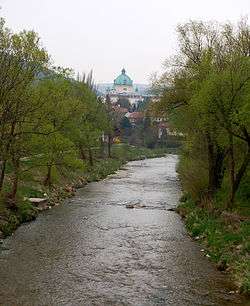Triesting
| Triesting | |
|---|---|
 The Triesting near Berndorf (with St. Margaret's Church) | |
| State | Lower Austria, Austria |
| Physical characteristics | |
| Main source |
East of the Klammhöhe, northwest of Kaumberg in the Vienna Woods 618 m (AA) 48°04′06″N 15°52′20″E / 48.06833°N 15.87222°ECoordinates: 48°04′06″N 15°52′20″E / 48.06833°N 15.87222°E |
| River mouth |
Near Achau into the Schwechat 172 m (AA) 48°04′52″N 16°23′57″E / 48.08111°N 16.39917°E |
| Length | 63.5 km (39.5 mi) [1] |
| Basin features | |
| Progression | Schwechat→ Danube→ Black Sea |
| Landmarks |
|
| Tributaries |
|
The Triesting is a river in the southeastern part of the Vienna Woods. It discharges into the smaller Schwechat at Achau and is part of the catchment area of the River Danube. It has a length of 63 km.
Floods
- 1846[2]
- July 1882
- May 1940
- July 1944
- July 1966
- July 1991 (flood wave only in the upper reaches)
- August 1997
- June 2002
The floods of 1944 were the worst ever in the Triesting valley. On 4 July 1944, there were severe floods, following heavy cloudbursts over the upper Triesting valley, in the vicinity of the Schöpfl mountain and in the Further valley. The narrow neck of the valley above Pottenstein was blocked by driftwood and the Fahrafeld Basin turned into a dammed lake. The dam broke and floodwaters up to 2 metres high surged through the valley. In the whole valley 188 people lost their lives, "the majority being foreign workers".[3][A 1][2]
References
- ↑ Niederösterreich Atlas (Lower Austria)
- 1 2 Helene Schießl, Erwin Schindler: Berndorfer Gemeindechronik, herausgegeben aus Anlass 100 Jahre Stadt Berndorf. Hrsg: Stadtgemeinde Berndorf. pp. 24ff
- ↑ Walter Rieck: Kulturgeographie des Triestingtales. p. 150
Sources
External links
| Wikimedia Commons has media related to Triesting. |
Remarks
- ↑ The lower Triesting valley, in particular, was a centre of the armaments industry, in which a considerable number of foreign workers were used to replace those liable for military wartime service. The majority of foreigners used for this work were slave labourers: POWs of various nationalities, "transferees" from the East and the Balkans, "which had been occupied during the war by the German Wehrmacht" (Rieck, p. 147).
This article is issued from
Wikipedia.
The text is licensed under Creative Commons - Attribution - Sharealike.
Additional terms may apply for the media files.